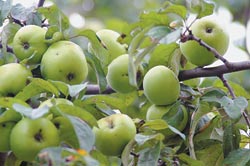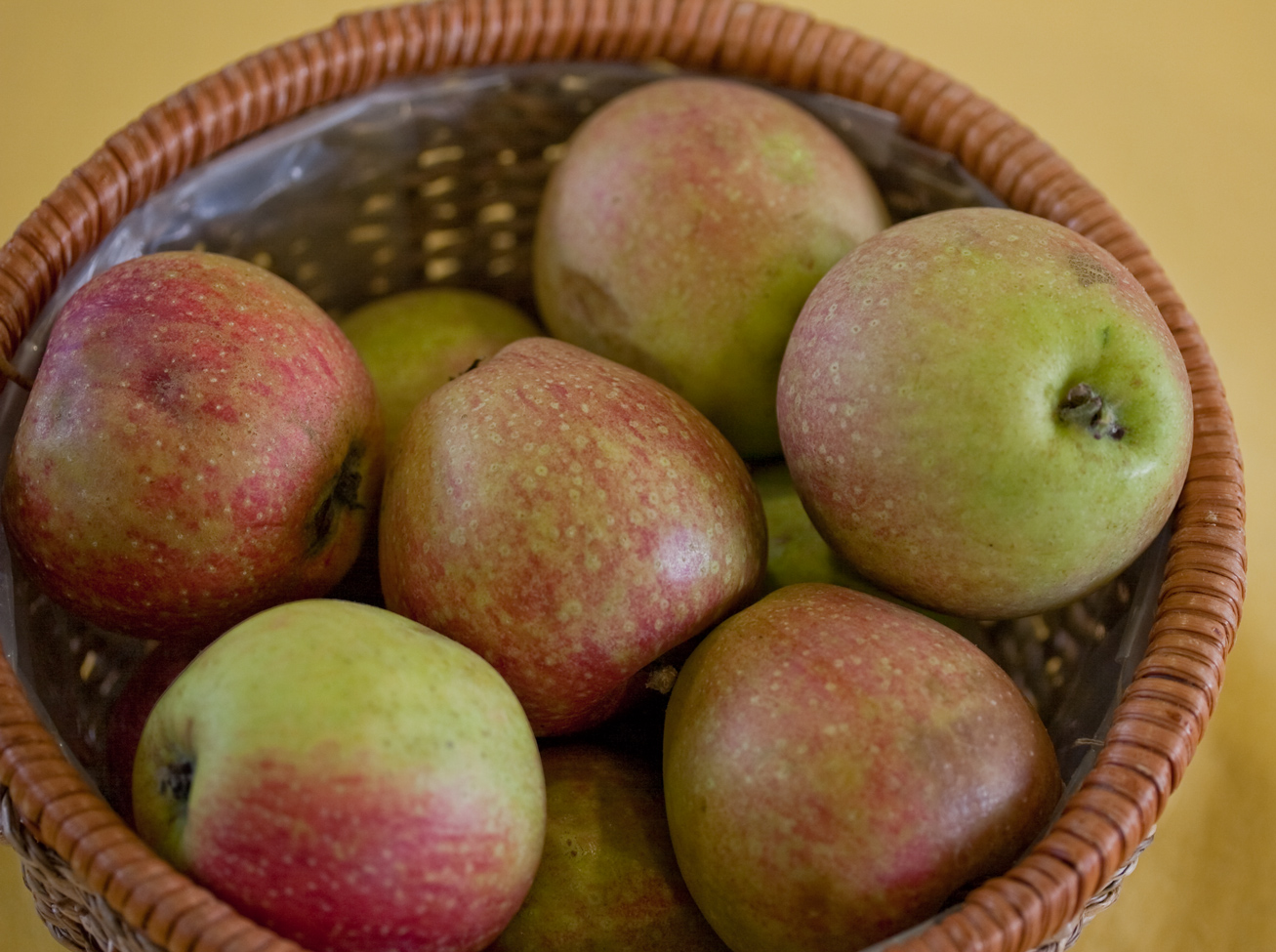|
Aia Ilu
Aia Ilu (in English, ''Garden Beauty'') is a cultivar of domesticated apple, from Estonia Estonia, formally the Republic of Estonia, is a country by the Baltic Sea in Northern Europe. It is bordered to the north by the Gulf of Finland across from Finland, to the west by the sea across from Sweden, to the south by Latvia, a ..., first developed in 1946 by Aleksander Siimon. Characteristics The Aia Ilu has large apples, weighing from 250 to 300 grams. It is juicy, bittersweet, and has a weak aroma. The Aia Ilu is grown in nurseries, but is not widely propagated. Pests The Aia Ilu has low scab resistance and is resistant to powdery mildew. References Apples Apple cultivars Agriculture in Estonia {{apple-fruit-stub ... [...More Info...] [...Related Items...] OR: [Wikipedia] [Google] [Baidu] |
Malus Pumila
An apple is an edible fruit produced by an apple tree (''Malus domestica''). Apple trees are cultivated worldwide and are the most widely grown species in the genus ''Malus''. The tree originated in Central Asia, where its wild ancestor, '' Malus sieversii'', is still found today. Apples have been grown for thousands of years in Asia and Europe and were brought to North America by European colonists. Apples have religious and mythological significance in many cultures, including Norse, Greek, and European Christian tradition. Apples grown from seed tend to be very different from those of their parents, and the resultant fruit frequently lacks desired characteristics. Generally, apple cultivars are propagated by clonal grafting onto rootstocks. Apple trees grown without rootstocks tend to be larger and much slower to fruit after planting. Rootstocks are used to control the speed of growth and the size of the resulting tree, allowing for easier harvesting. There are more ... [...More Info...] [...Related Items...] OR: [Wikipedia] [Google] [Baidu] |
Antonovka
Antonovka (russian: Антоновка, pl, Antonówka) is a group of late-fall or early-winter apple cultivars with a strong acid flavor that have been popular in Russia (Soviet Union and the Russian Empire) as well as in Poland and Belarus. The most popular Russian variety is Common Antonovka (Антоновка обыкновенная), from which other cultivars derive. It was developed by pioneer Russian naturalist and plant breeder Ivan V. Michurin at his experimental orchard in the Tambov Oblast and introduced in 1888. Antonovka is famous for its unsurpassed strong and pleasant fruit aroma. Polish varieties Poland has two varieties: ''Antonówka Zwykła'' (same, as in Russia) and ''Antonówka Biała'' also known as ''Śmietankowa'' (Antonówka White or Creamy) with considerably larger and whiter fruit ripening in late September, but also a shorter shelf life. Hardiness The popularity of the Antonovka tree is enhanced by its ability to sustain long harsh win ... [...More Info...] [...Related Items...] OR: [Wikipedia] [Google] [Baidu] |
Estonia
Estonia, formally the Republic of Estonia, is a country by the Baltic Sea in Northern Europe. It is bordered to the north by the Gulf of Finland across from Finland, to the west by the sea across from Sweden, to the south by Latvia, and to the east by Lake Peipus and Russia. The territory of Estonia consists of the mainland, the larger islands of Saaremaa and Hiiumaa, and over 2,200 other islands and islets on the eastern coast of the Baltic Sea, covering a total area of . The capital city Tallinn and Tartu are the two largest urban areas of the country. The Estonian language is the autochthonous and the official language of Estonia; it is the first language of the majority of its population, as well as the world's second most spoken Finnic language. The land of what is now modern Estonia has been inhabited by '' Homo sapiens'' since at least 9,000 BC. The medieval indigenous population of Estonia was one of the last "pagan" civilisations in Europe to adop ... [...More Info...] [...Related Items...] OR: [Wikipedia] [Google] [Baidu] |
List Of Apple Cultivars
Over 7,500 cultivars of the culinary or eating apple (''Malus domestica'') are known. Some are extremely important economically as commercial products, though the vast majority are not suitable for mass production. In the following list, use for "eating" means that the fruit is consumed raw, rather than cooked. Cultivars used primarily for making cider are indicated. Those varieties marked have gained the Royal Horticultural Society's Award of Garden Merit. This list does not include the species and varieties of apples collectively known as crab apples, which are grown primarily for ornamental purposes, though they may be used to make jelly or compote. These are described under ''Malus ''Malus'' ( or ) is a genus of about 30–55 species of small deciduous trees or shrubs in the family Rosaceae, including the domesticated orchard apple, crab apples, wild apples, and rainberries. The genus is native to the temperate zo ...''. Table of apples Cider apple ... [...More Info...] [...Related Items...] OR: [Wikipedia] [Google] [Baidu] |
Apple
An apple is an edible fruit produced by an apple tree (''Malus domestica''). Apple trees are cultivated worldwide and are the most widely grown species in the genus '' Malus''. The tree originated in Central Asia, where its wild ancestor, '' Malus sieversii'', is still found today. Apples have been grown for thousands of years in Asia and Europe and were brought to North America by European colonists. Apples have religious and mythological significance in many cultures, including Norse, Greek, and European Christian tradition. Apples grown from seed tend to be very different from those of their parents, and the resultant fruit frequently lacks desired characteristics. Generally, apple cultivars are propagated by clonal grafting onto rootstocks. Apple trees grown without rootstocks tend to be larger and much slower to fruit after planting. Rootstocks are used to control the speed of growth and the size of the resulting tree, allowing for easier harvesting. There ... [...More Info...] [...Related Items...] OR: [Wikipedia] [Google] [Baidu] |
Gram
The gram (originally gramme; SI unit symbol g) is a unit of mass in the International System of Units (SI) equal to one one thousandth of a kilogram. Originally defined as of 1795 as "the absolute weight of a volume of pure water equal to the cube of the hundredth part of a metre melting ice", the defining temperature (~0 °C) was later changed to 4 °C, the temperature of maximum density of water. However, by the late 19th century, there was an effort to make the Base unit (measurement), base unit the kilogram and the gram a derived unit. In 1960, the new International System of Units defined a ''gram'' as one one-thousandth of a kilogram (i.e., one gram is Scientific notation, 1×10−3 kg). The kilogram, as of 2019, is defined by the International Bureau of Weights and Measures from the fixed numerical value of the Planck constant (), which is kg⋅m2⋅s−1. Official SI symbol The only unit symbol for gram that is recognised by the International S ... [...More Info...] [...Related Items...] OR: [Wikipedia] [Google] [Baidu] |
Apple Scab
Apple scab is a common disease of plants in the rose family (Rosaceae) that is caused by the ascomycete fungus '' Venturia inaequalis''. While this disease affects several plant genera, including '' Sorbus, Cotoneaster,'' and ''Pyrus'', it is most commonly associated with the infection of '' Malus'' trees, including species of flowering crabapple, as well as cultivated apple. The first symptoms of this disease are found in the foliage, blossoms, and developing fruits of affected trees, which develop dark, irregularly-shaped lesions upon infection. Although apple scab rarely kills its host, infection typically leads to fruit deformation and premature leaf and fruit drop, which enhance the susceptibility of the host plant to abiotic stress and secondary infection.Jha, G., Thakur, K., & Thakur, P. (2009). The ''Venturia'' Apple Pathosystem: Pathogenicity Mechanisms and Plant Defense Responses. ''Journal of Biomedicine and Biotechnology'', 2009. doi:10.1155/2009/680160 The reductio ... [...More Info...] [...Related Items...] OR: [Wikipedia] [Google] [Baidu] |
Podosphaera Leucotricha
''Podosphaera leucotricha'' is a plant pathogen that can cause powdery mildew of apple An apple is an edible fruit produced by an apple tree (''Malus domestica''). Apple trees are cultivated worldwide and are the most widely grown species in the genus '' Malus''. The tree originated in Central Asia, where its wild ances ...s and pears. Importance A net-like russeting can cut the value of fruit in half and with some orchards spraying up to 15 times per growing season the economic losses from P. leucotricha are high. Hosts and symptoms Powdery mildew, caused by the obligate biotrophic ascomycete ''Podosphaera leucotricha'', is one of the major diseases of cultivated apple throughout the world. The primary host is apple, but other fruit like peaches and quince provide a host for ''Podosphaera leucotricha.'' Ellis, M. A., Ferree, D. C., and Spring, D. E. 1981. Photosynthesis, transpiration, and carbohydrate content of apple leaves infected by Podosphaera leucotr ... [...More Info...] [...Related Items...] OR: [Wikipedia] [Google] [Baidu] |
Apples
An apple is an edible fruit produced by an apple tree (''Malus domestica''). Apple trees are cultivated worldwide and are the most widely grown species in the genus ''Malus''. The tree originated in Central Asia, where its wild ancestor, ''Malus sieversii'', is still found today. Apples have been grown for thousands of years in Asia and Europe and were brought to North America by European colonists. Apples have religious and mythological significance in many cultures, including Norse, Greek, and European Christian tradition. Apples grown from seed tend to be very different from those of their parents, and the resultant fruit frequently lacks desired characteristics. Generally, apple cultivars are propagated by clonal grafting onto rootstocks. Apple trees grown without rootstocks tend to be larger and much slower to fruit after planting. Rootstocks are used to control the speed of growth and the size of the resulting tree, allowing for easier harvesting. There are more th ... [...More Info...] [...Related Items...] OR: [Wikipedia] [Google] [Baidu] |
Apple Cultivars
Over 7,500 cultivars of the culinary or eating apple (''Malus domestica'') are known. Some are extremely important economically as commercial products, though the vast majority are not suitable for mass production. In the following list, use for "eating" means that the fruit is consumed raw, rather than cooked. Cultivars used primarily for making cider are indicated. Those varieties marked have gained the Royal Horticultural Society's Award of Garden Merit. This list does not include the species and varieties of apples collectively known as crab apples, which are grown primarily for ornamental purposes, though they may be used to make jelly or compote. These are described under '' Malus''. Table of apples Cider apples Cider apples are a variety of apples that may be far too sour or bitter for fresh eating, but are used for making cider. Varieties in ''italics'' are used for both cider and eating purposes. shp = sharp, swt = sweet, bswt = bittersweet, bshp = bitt ... [...More Info...] [...Related Items...] OR: [Wikipedia] [Google] [Baidu] |



.jpg)
